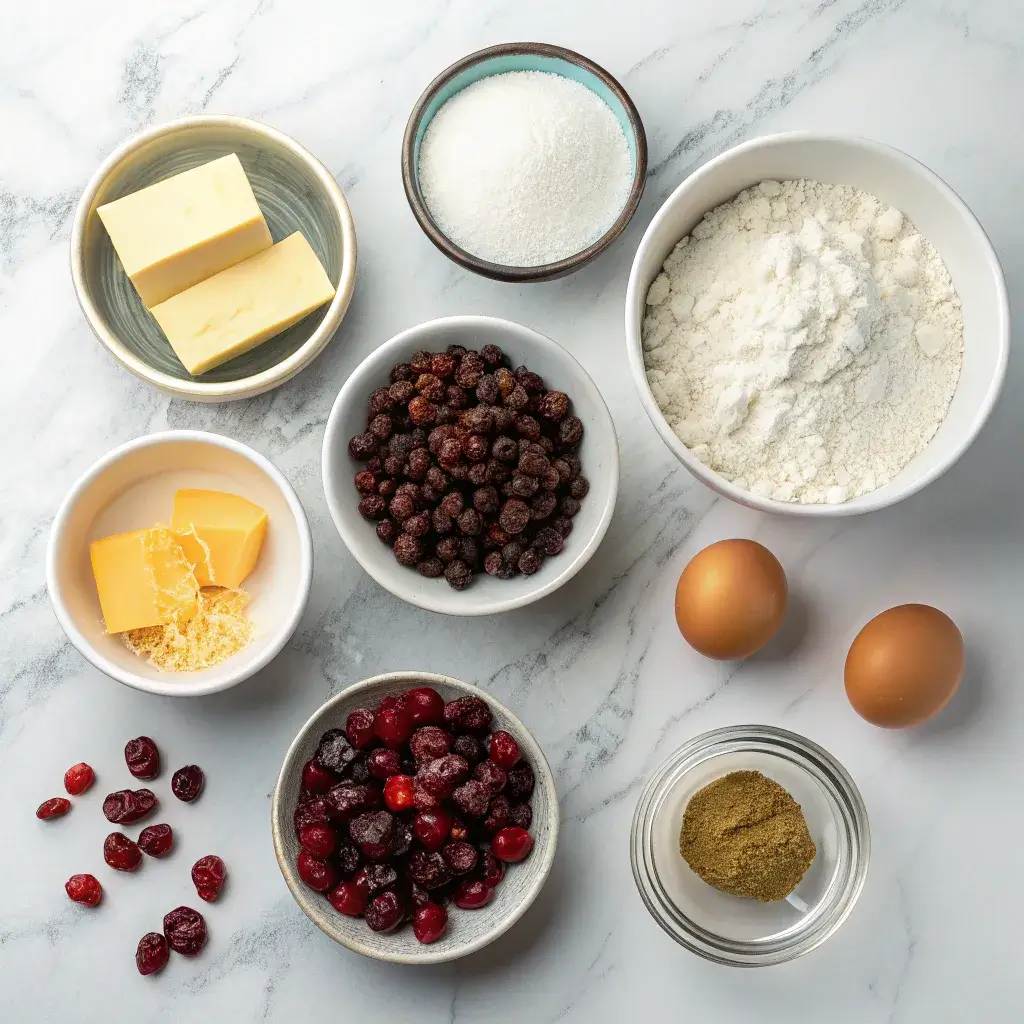The Canadian fruit cookie is more than just a dessert; it’s a piece of Canadian culinary heritage. With roots tracing back to the late 19th century, this cookie blends the warmth of traditional baking with the bright sweetness of dried fruits.
The Canadian fruit cookie, loved throughout the provinces, remains a timeless favorite often enjoyed during holidays, at family gatherings, and with afternoon tea.
The Origins of the Canadian Fruit Cookie
A brief history of Canadian cookies
Cookies in Canada have always reflected the country’s rich cultural influences from French butter treats to British shortbreads and Indigenous-inspired recipes. The Canadian fruit cookie stands out as one of the most iconic, especially because it brings together the love of hearty baking and the availability of dried fruits, which stored well through harsh winters.
In the late 1800s, when sugar and dried fruits became more accessible, Canadian bakers embraced fruit-filled cookies as a festive and nourishing treat. They weren’t just desserts, they were symbols of hospitality and celebration.
Why fruit cookies became a national favorite
The rise of the Canadian fruit cookie is also connected with Canada’s seasonal traditions. In times when fresh fruit was scarce, dried currants, raisins, and candied peels served as ideal substitutes, keeping recipes flavorful year-round. These cookies became holiday staples, especially at Christmas, and their popularity spread from coast to coast.
Today, they’re still celebrated as a nostalgic dessert that links generations of bakers. Whether enjoyed with tea on a snowy afternoon or gifted during the holidays, they remain a comforting classic.
For another nostalgic favorite, check out our Healthy Rice Krispie Treats—a modern twist on a timeless snack.
Print
Canadian Fruit Cookie: A Sweet Slice of Canada’s Baking History
- Total Time: 30 minutes
- Yield: 24 cookies 1x
- Diet: Vegetarian
Description
Soft and chewy Canadian-style fruit cookies filled with raisins, dates, and warm spices — a cozy treat perfect with tea or coffee.
Ingredients
1/2 cup unsalted butter, softened
3/4 cup brown sugar
1 large egg
1 tsp vanilla extract
1 1/2 cups all-purpose flour
1 tsp baking powder
1/2 tsp baking soda
1/2 tsp cinnamon
1/4 tsp nutmeg
1/4 tsp salt
1/2 cup chopped dates
1/2 cup raisins or currants
1/2 cup chopped walnuts or pecans (optional)
2 tbsp milk
Instructions
1. Preheat oven to 350°F (175°C). Line a baking sheet with parchment paper.
2. In a large mixing bowl, cream together the butter and brown sugar until light and fluffy.
3. Beat in the egg and vanilla until smooth.
4. In a separate bowl, whisk together the flour, baking powder, baking soda, cinnamon, nutmeg, and salt.
5. Gradually add the dry ingredients to the wet mixture, alternating with the milk, until just combined.
6. Fold in the chopped dates, raisins, and nuts if using.
7. Drop tablespoon-sized portions of dough onto the prepared baking sheet, spacing about 2 inches apart.
8. Bake for 10–12 minutes, or until the edges are lightly golden but the centers remain soft.
9. Cool on the baking sheet for 5 minutes before transferring to a wire rack to cool completely.
Notes
These cookies taste even better the next day as the fruit flavors meld.
For variety, substitute dried cranberries or cherries for the raisins.
Store in an airtight container at room temperature for up to 5 days, or freeze for up to 2 months.
- Prep Time: 15 minutes
- Cook Time: 12 minutes
- Category: Dessert
- Method: Baking
- Cuisine: Canadian
Nutrition
- Serving Size: 1 cookie
- Calories: 110
- Sugar: 9g
- Sodium: 70mg
- Fat: 4g
- Saturated Fat: 2g
- Unsaturated Fat: 2g
- Trans Fat: 0g
- Carbohydrates: 17g
- Fiber: 1g
- Protein: 2g
- Cholesterol: 15mg
Keywords: Canadian fruit cookie, raisin cookies, old-fashioned cookies, date cookies
What Cookies Is Canada Famous For?
From shortbreads to butter tarts in cookie form
Canada’s cookie culture is as diverse as the country itself. While the Canadian fruit cookie holds a special place, there are other iconic cookies beloved across provinces.
- Shortbread Cookies Brought from Scotland, shortbreads are rich, buttery, and especially popular during Christmas.
- Maple Cookies Sweetened with pure Canadian maple syrup, these crisp treats celebrate one of Canada’s most famous exports.
- Butter Tart Cookies Inspired by Canada’s classic butter tarts, these cookies feature gooey centers and flaky edges.
- Oatmeal Raisin Cookies A hearty choice, especially in regions where oats were a staple crop.
The Canadian fruit cookie, often loaded with raisins, currants, or candied peel, fits right alongside these favorites. It’s both traditional and versatile, making it one of the country’s best-loved desserts.
Regional cookie favorites across Canada
Each region has its own twist on cookies. In the Maritimes, molasses cookies are a staple. Quebec boasts maple-infused delights, while the Prairies often favor hearty oat-based cookies.
But across the board, the Canadian fruit cookie appears on tables during holidays and community gatherings. Its combination of chewy fruit and lightly spiced dough reflects Canada’s multicultural baking influences and its love of comforting sweets.
If you’re curious about more traditional bites, try our Sourdough Discard Pretzel Bites, a savory favorite that shows just how creative Canadian kitchens can be.
Arrowroot Cookies and San Nicolas Tradition
Why are arrowroot cookies called San Nicolas cookies?
While the Canadian fruit cookie is a festive staple, another cookie tied to Canadian baking history is the arrowroot cookie. Known in some circles as San Nicolas cookies, these treats trace their name back to the city of San Nicolás in Pampanga, Philippines, where arrowroot cookies became a traditional delicacy.
Immigrants from the Philippines and other cultures enriched Canada’s cookie traditions by introducing their beloved recipes. Arrowroot powder, light, starchy, and gluten-free, gave cookies a delicate crunch, making them a popular alternative for those seeking a lighter dessert.
The blending of these cultural influences shows how Canadian baking is not just local it’s global, with flavors and recipes traveling across continents.
How they became part of Canadian kitchens
Arrowroot cookies gained popularity in Canadian homes because they were easy to digest and considered suitable for children and even those recovering from illness. Over time, they became a pantry staple, enjoyed with tea or as a light snack.
Though different from the Canadian fruit cookie, arrowroot cookies reflect the same traditions of warmth, sharing, and adapting international recipes into Canadian kitchens.
For another cultural fusion treat, check out our Maque-Style Mexican Biscuits, a perfect example of how food connects traditions across borders.
The 1891 Fruit Cookie Creation
What fruit cookie was created in 1891?
The roots of the Canadian fruit cookie can be traced back to 1891, when recipes featuring dried fruits, sugar, and simple flour blends first appeared in Canadian cookbooks. These early fruit cookies often used raisins and currants, two ingredients that were affordable and easy to store through Canada’s cold winters.
This 1891 creation wasn’t just about sweetness, it was about practicality. Dried fruits provided natural sugars and nutrients, making the cookie both a treat and a source of energy.

Its legacy in Canadian households today
More than a century later, the Canadian fruit cookie remains a holiday tradition. Families still bake versions of this classic, often handed down through generations. Its legacy isn’t just in flavor but in the memories of holiday kitchens filled with warmth, family stories, and the smell of fruit-laden cookies baking.
Canadian English vs. American English – What Is a Cookie?
Language influences how we name our favorite baked goods, and the Canadian fruit cookie is no exception. To understand its place in Canadian kitchens, let’s explore the differences between Canadian and American English.
The Meaning of “Cookie” in Canadian English
- Shared with American English: In Canada, cookie refers to the same sweet, baked treat as in the United States.
- Not “Biscuit”: Unlike in Britain, where “biscuit” often means a cookie, Canadians use “biscuit” for savory, bread‑like items.
- Consistency Across North America: This means a Canadian fruit cookie is universally recognized as a sweet treat in both Canada and the U.S.
- British Contrast: In Britain, the same baked good might be called a fruit biscuit.
Biscuit vs. Cookie: Clearing the Confusion
- Canadian English Heritage: Influenced by both British and American roots.
- Common Use in Canada: Cookie always means sweet; biscuit refers to items like scones or buttermilk biscuits.
- Practical Result: When Canadians say fruit cookie, there’s no confusion; everyone expects a sweet, fruit‑filled treat.
“Cookie” vs. “Biscuit”
| Term | Canadian English | American English | British English |
|---|---|---|---|
| Cookie | Always a sweet baked treat | Always a sweet baked treat | Less common; often replaced with biscuit |
| Biscuit | Savory, bread‑like item (like a scone) | Savory, bread‑like item (buttermilk) | Sweet baked good (like a cookie) |
| Example | Canadian fruit cookie with raisins & dates | Chocolate chip cookie | Digestive biscuit, fruit shortbread |
Ingredients That Define a Canadian Fruit Cookie
Canadian fruit cookies are a beloved treat that combine tradition with modern creativity. The ingredients you choose determine whether your cookie leans toward a nostalgic classic or a fresh, updated version.

Key Ingredient Focus: Dried Fruits
- Raisins: Provide natural sweetness and a chewy bite.
- Currants: Add a tangy, slightly tart flavor.
- Chopped Dates: Give depth and caramel-like notes.
- Candied Peel: Offers a citrusy brightness.
- Historical Role: In earlier times, these ingredients were valued for their long shelf life, helping families enjoy sweet treats through Canada’s harsh winters.
Traditional vs. Modern Ingredient Choices
| Ingredient Category | Traditional Canadian Fruit Cookie | Modern Canadian Fruit Cookie |
|---|---|---|
| Base Ingredients | Flour, butter, sugar, eggs | Gluten-free flour blends, coconut sugar, or almond flour |
| Fruits | Raisins, currants, chopped dates, candied peel | Cranberries, cherries, blueberries, dried apricots |
| Sweetness | White sugar | Coconut sugar, honey, or maple syrup |
| Extras | Rarely included | Chocolate chips, nuts, or seeds for added texture & nutrients |
Tips for a Healthier Spin
- Use Gluten-Free Flour: Perfect for those with sensitivities or gluten intolerance.
- Swap Sugars: Replace refined white sugar with coconut sugar or maple syrup for a richer flavor.
- Add Nutrient Boosts: Walnuts, almonds, or chia seeds can add protein and healthy fats.
Why This Balance Matters
By blending traditional ingredients with modern variations, the Canadian fruit cookie remains relevant for today’s kitchens while honoring its roots. This approach ensures everyone, from nostalgic bakers to health-conscious snackers, can enjoy this timeless cookie.
For another nostalgic recipe, check out our Healthy Rice Krispie Treats, a healthier spin on a Canadian classic.
Baking the Perfect Canadian Fruit Cookie
Step-by-step method
Making the Canadian fruit cookie at home is both simple and rewarding:
- Cream butter and sugar until light and fluffy.
- Add eggs and vanilla for structure and flavor.
- Mix dry ingredients: flour, baking powder, and a pinch of salt.
- Fold in dried fruits like raisins, currants, or cranberries.
- Scoop dough onto a parchment-lined baking tray.
- Bake at 350°F (175°C) for 10–12 minutes until lightly golden.
Tips for chewy yet crisp results
- Soak dried fruits: Place them in warm water or juice for 10 minutes to make them plump and flavorful.
- Chill the dough: Refrigerate for about 20 minutes before baking to prevent spreading.
- Watch the bake: Don’t overbake cookies should be golden around the edges while staying soft in the middle.
Canadian Fruit Cookies in Modern Times
Gluten-free and healthier adaptations
- Go gluten-free: Use a 1:1 gluten-free flour blend to make these cookies safe for those with celiac disease.
- Choose natural sweeteners: Replace white sugar with coconut sugar or maple syrup for a richer, more wholesome sweetness.
- Boost nutrition: Add chia seeds or flaxseed for extra fiber, omega-3s, and a subtle nutty flavor.
Serving Ideas for Holidays & Celebrations
These cookies truly shine during Christmas, Thanksgiving, and other festive gatherings. They pair beautifully with warm drinks like tea, coffee, or mulled cider, making them a cozy seasonal treat. Many families also carry on the tradition of gifting tins of Canadian fruit cookies to friends and loved ones during the holidays.

Where to Find Canadian Fruit Cookies Today
Local bakeries and online shops
Many local bakeries across Canada still offer the Canadian fruit cookie, especially during the winter holidays. They can also be found in specialty stores that focus on heritage baking.
Online, recipes abound, allowing anyone to recreate this classic at home. Specialty e-shops may also sell pre-packaged fruit cookies for those craving authentic flavor without baking.
Making them at home with family traditions
While store-bought options are convenient, baking the Canadian fruit cookie at home remains the best way to connect with tradition. Many families pass down handwritten recipes, often slightly different but all rich in history and flavor.
FAQ Section: Canadian Fruit Cookie
What cookies is Canada famous for?
Canada is famous for buttery shortbread cookies, maple-flavored cookies, gooey butter tart cookies, and the classic Canadian fruit cookie, loaded with raisins and currants.
Why are arrowroot cookies called San Nicolas cookies?
Arrowroot cookies are called San Nicolas cookies because they originated in San Nicolás, Pampanga (Philippines). Immigrants introduced them to Canada, where they became a light, crunchy pantry staple.
What fruit cookie was created in 1891?
The Canadian fruit cookie was first documented in Canadian cookbooks in 1891. Originally baked with raisins and currants, it quickly became a household favorite for its sweetness and long shelf life.
What is a cookie in Canadian English?
In Canadian English, a cookie means a sweet baked good similar to the American version. Unlike British English, where “biscuit” is used, Canadians distinguish cookies (sweet) from biscuits (savory).
Conclusion
The Canadian fruit cookie is more than just a dessert it’s a culinary tradition that bridges Canada’s past and present. From its 1891 debut to today’s gluten-free and modern versions, it continues to warm kitchens across the country.
Whether you’re enjoying them during the holidays, gifting them to loved ones, or baking them as a weekend project, the Canadian fruit cookie remains a beloved symbol of comfort and heritage.
For more sweet inspiration, try our Healthy Rice Krispie Treats, Maque-Style Mexican Biscuits, and Sourdough Discard Pretzel Bites.

